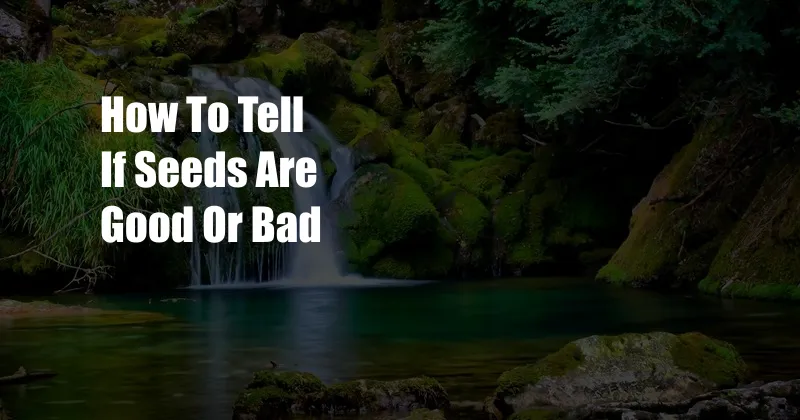
How to Tell if Seeds Are Good or Bad
Seeds are an essential part of our food system, providing us with a wealth of nutrients and flavor. But how can you tell if seeds are good or bad? Whether you’re a seasoned gardener or just starting out, understanding the signs of seed viability is crucial for successful planting.
In this comprehensive guide, we’ll delve into the world of seed quality, exploring the factors that determine their viability and longevity. From physical appearance to germination tests, we’ll equip you with the knowledge and techniques you need to make informed decisions about your seeds.
The Importance of Seed Viability
Seed viability refers to the ability of a seed to germinate and produce a healthy plant. Viable seeds are essential for successful gardening, as they contain the genetic information and resources necessary for plant growth. By selecting viable seeds, you increase your chances of a thriving garden with bountiful harvests.
Seed viability can be affected by various factors, including age, storage conditions, and environmental stresses. Understanding these factors and implementing proper storage practices can significantly improve seed longevity and ensure optimal germination rates.
Physical Examination
One of the first steps in determining seed viability is a thorough physical examination. Inspect your seeds carefully, looking for any signs of damage, discoloration, or mold. Healthy seeds should be firm to the touch, have a uniform color, and be free from cracks or holes.
Plumpness: Viable seeds will be plump and round, indicating that they contain ample food reserves for germination and early growth.
Color: Check the color of the seeds. Most viable seeds will have a healthy, uniform color, free from any discoloration or spotting.
Absence of damage: Examine the seeds for any cracks, holes, or other physical damage. Damaged seeds may have reduced viability and are more likely to succumb to disease.
Germination Tests
While a physical examination can provide some insight into seed viability, germination tests are a more reliable method for assessing their potential for growth. There are several germination tests you can perform:
Paper Towel Test: Moisten a paper towel and place the seeds between the layers. Fold the paper towel and keep it in a warm, dark place. Check the seeds daily for germination.
Water Test: Fill a clear glass or jar with water and add the seeds. Viable seeds will sink to the bottom, while non-viable seeds will float on the surface.
Soil Test: Plant the seeds in a small pot filled with moist potting mix. Place the pot in a warm, sunny location and monitor the germination rate.
Other Factors Affecting Seed Viability
In addition to physical appearance and germination tests, other factors can impact seed viability:
Age: The age of seeds significantly affects their viability. Most seeds have a shelf life of several years, but older seeds are less likely to germinate successfully.
Storage Conditions: Seeds should be stored in cool, dry, and dark conditions to maintain their viability. Exposure to heat, moisture, or light can reduce seed quality over time.
Environmental Stresses: Extreme temperatures, drought, or other environmental stresses can damage seeds and reduce their viability.
Tips for Storing Seeds Properly
Proper seed storage is essential for preserving their viability. Follow these tips to ensure your seeds remain viable for as long as possible:
Choose airtight containers: Store seeds in airtight containers to prevent moisture and oxygen from entering. This will help to maintain seed quality.
Keep seeds cool and dry: Store seeds in a cool, dry place, such as a refrigerator or basement. Avoid exposing seeds to heat or high humidity.
Use desiccant packets: Place desiccant packets in the seed containers to absorb excess moisture. This will help to keep the seeds dry and prevent mold growth.
FAQ on Seed Viability
Q: How long do seeds last?
A: Seed longevity varies depending on the species. Some seeds can remain viable for decades, while others may only be viable for a few years.
Q: Can I save seeds from my own plants?
A: Yes, you can save seeds from your own plants, but it is important to select healthy, mature plants for seed production. Proper drying and storage techniques are crucial to ensure seed viability.
Q: What should I do with non-viable seeds?
A: Non-viable seeds can be discarded or used for composting. Composting can help to recycle nutrients back into the soil.
Conclusion
Determining seed viability is an essential skill for successful gardening. By understanding the physical characteristics, germination tests, and other factors that affect seed quality, you can make informed decisions about your seeds and increase your chances of a thriving garden. Remember, viable seeds are the foundation for healthy plants and abundant harvests.
Are you interested in learning more about seed viability and other aspects of gardening? Join our online gardening community or follow us on social media for the latest tips, tricks, and updates.